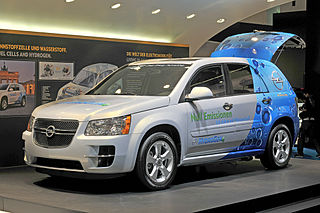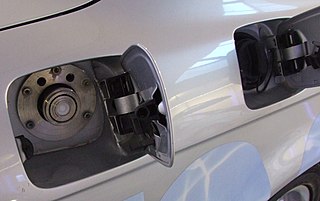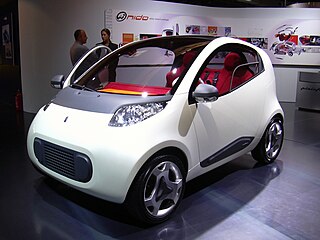
A hydrogen vehicle is a vehicle that uses hydrogen fuel for motive power. Hydrogen vehicles include road vehicles, rail vehicles and hydrogen-fueled space rockets, as well as hydrogen-powered ships and aircraft. Motive power is generated by converting the chemical energy of hydrogen to mechanical energy, either by reacting hydrogen with oxygen in a fuel cell to power electric motors or, less commonly, by hydrogen internal combustion.

A fuel cell vehicle (FCV) or fuel cell electric vehicle (FCEV) is an electric vehicle that uses a fuel cell, sometimes in combination with a small battery or supercapacitor, to power its onboard electric motor. Fuel cells in vehicles generate electricity generally using oxygen from the air and compressed hydrogen. Most fuel cell vehicles are classified as zero-emissions vehicles that emit only water and heat. As compared with internal combustion vehicles, hydrogen vehicles centralize pollutants at the site of the hydrogen production, where hydrogen is typically derived from reformed natural gas. Transporting and storing hydrogen may also create pollutants. Fuel cells have been used in various kinds of vehicles including forklifts, especially in indoor applications where their clean emissions are important to air quality, and in space applications. Fuel cells are being developed and tested in trucks, buses, boats, ships, motorcycles and bicycles, among other kinds of vehicles.

The Chevrolet Sequel is a purpose-built hydrogen fuel cell-powered concept car and sport utility vehicle from Chevrolet, employing the then-latest generation of General Motors' fuel cell technology.

The Ford Airstream is a concept car built by Ford that made its debut at the 2007 North American International Auto Show in Detroit, Michigan. The Ford Airstream is a retro-futuristic crossover utility vehicle that was inspired by the classic Airstream recreational vehicle trailers built since the 1930s. The modern Ford Airstream concept includes a plug-in hybrid hydrogen fuel cell drive system, called HySeries Drive, that operates exclusively on electrical power. Ford calls the Ford Airstream Concept "a futuristic look at crossovers" as "modern touring vehicle(s)" for recreational travelers. The concept vehicle was designed in cooperation with Airstream, a division of Thor Industries. The design and name of the Airstream were possibly influenced by the Ford Aerostar.
The Honda FCX is a family of hydrogen fuel cell automobiles manufactured by Honda.

HydroGen4 is the successor of the fuel cell vehicle HydroGen3, developed by General Motors/Opel and presented in 2007 at the IAA in Frankfurt, Germany. It is expected that automotive hydrogen technology, such as the type featured in the HydroGen4, may enter the early commercialization phase in the 2015–2020 time frame.

The Mazda Premacy Hydrogen RE Hybrid or Mazda5 Hydrogen RE Hybrid was a hydrogen powered hybrid car produced by Mazda. Later models were also called the Mazda Hydrogen RE Plug in Hybrid. The first car was unveiled in 2005, with an improved version shown at the 2007 Tokyo Motor Show. Mazda planned for the car to enter production and leased a few cars to end users in 2009 in 2010.

A hydrogen internal combustion engine vehicle (HICEV) is a type of hydrogen vehicle using an internal combustion engine. Hydrogen internal combustion engine vehicles are different from hydrogen fuel cell vehicles. Instead, the hydrogen internal combustion engine is simply a modified version of the traditional gasoline-powered internal combustion engine. The absence of carbon means that no CO2 is produced, which eliminates the main greenhouse gas emission of a conventional petroleum engine.

The Mercedes-Benz BlueZERO concept is Mercedes' attempt at the alternative fuel vehicle movement. The BlueZERO is a flexible concept that has the ability to accommodate the three different types of future alternative fuels: electric, hybrid, and hydrogen fueled. It was first introduced at the 2009 Detroit Auto Show which took place January 11–25. It features a single vehicle architecture that accommodates three models with different electric power-train configurations, each of which are fully developed and ready for testing. The Mercedes-Benz BlueZERO electric drive system gives each model the same performance specifications for acceleration and top speed. The Mercedes-Benz BlueZERO electric drive modular design accelerates from 0 to 100 km/h (62.5 mph) in under 11 seconds, and the top speed is electronically governed to 150 km/h (93 mph) in the interests of optimal range and energy efficiency. Peak torque is 320 N⋅m (236 lb⋅ft) and as with all EVs, maximum torque is available from zero rpm.

The Mercedes-Benz F-Cell Roadster is a concept car produced by the German car company Mercedes-Benz. During April 2009, the concept car has traveled the Bertha Benz Memorial Route thus celebrating the exploits of Mrs. Bertha Benz in 1888.
Toyota concept vehicles are transportation devices manufactured or designed by automobile company Toyota from 2000 to 2009. As their name suggests, these vehicles were concepts, and, as such, many were never released to dealerships. Many were developed in conjunction with other corporations such as Sony or Subaru.

Riversimple is a United Kingdom-based car manufacturer of hydrogen-powered fuel cell electric vehicles (FCEVs). It is based in Llandrindod Wells, a town in Wales, where there is a research & development centre and the company's offices. Riversimple was founded by former motorsport engineer and racing driver Hugo Spowers.
Lowie Vermeersch is a Flemish designer, part of the third generation of a prominent artistic family. He is the Founder & Creative Director of Granstudio in Turin, Italy.

The Pininfarina Nido is a concept car designed by Pininfarina and introduced at the 2004 Paris Motor Show. In Italian, the word Nido means nest, in fact the single-box shape of the car conveys an impression of a protective nest surrounding the occupants.

Alset Global GmbH is an Austrian technology and engineering company based in Graz that is specialized in hydrogen-based clean mobility products. Alset Global developed a Hybrid Hydrogen system of which the technology is patented. According to Alset Global, this technology is unique as it offers to run an internal combustion engine on either pure petrol, pure hydrogen or a combination of both. The technology offers a new sustainable and clean alternative to the automotive industry. The technology has been developed to create an alternative technology to meet new emission target levels. In addition, Alset Global is specialised in hydrogen system integration, hydrogen gas storage, and software development to utilize the hydrogen hybrid technology in the automotive industry.
This is a list of concept vehicles made by Toyota from the years 2020–2029.

The Hyundai N Vision 74 is a concept car developed by Hyundai, based on the 1974 pony coupe unveiled at the Turin Auto Show in 1974. The sporty car was unveiled at N Day 2022, an event organized by the Hyundai N performance division in mid-July 2022 at Busan, South Korea, alongside the Hyundai RN22e concept based on the Hyundai Ioniq 6 electric vehicle. The N Vision 74 is a rear-wheel-drive coupe driven by two electric traction motors, both on the rear axle; power is provided by both a storage battery and a hydrogen fuel cell.

The Hyundai Vision FK is a concept car that uses a plug-in hybrid drivetrain with both a large traction battery and a hydrogen fuel cell; the concept vehicle was developed by Hyundai and Rimac Automobili. The mid-motor, rear-wheel-drive sports coupe was unveiled at the Hydrogen Wave Forum in September 2021, an event organized by Hyundai to outline its plans to popularize hydrogen vehicles by 2040 for "Everyone, Everything and Everywhere". Power is delivered through two electric traction motors, both on the rear axle. The Vision FK can be plugged in to recharge its traction battery, which has more than 60 kW-hr of energy storage capacity, and the onboard fuel cell affords it a range greater than 600 km (370 mi).















